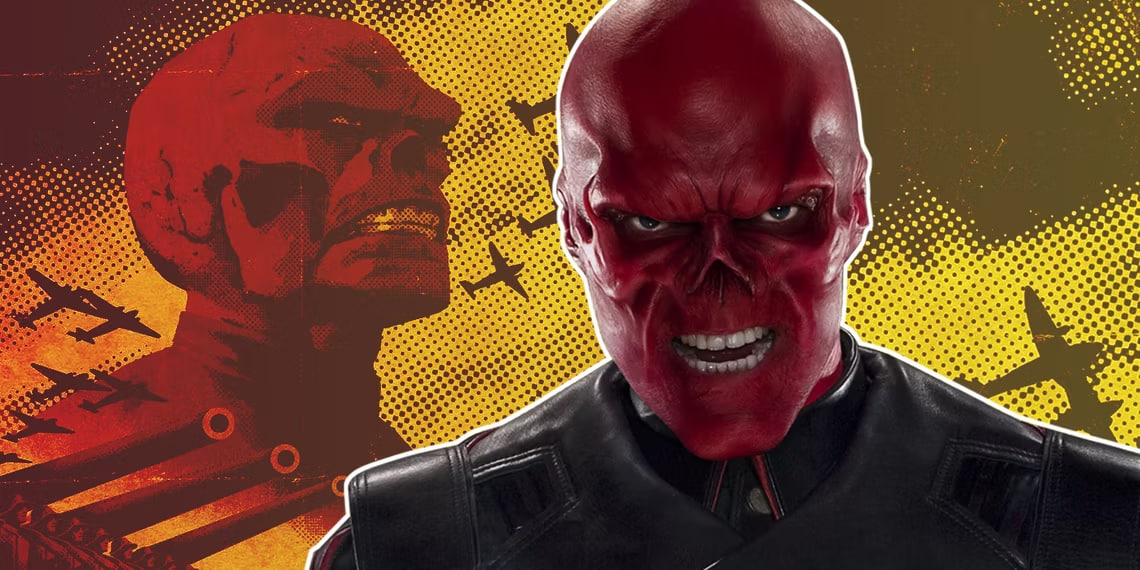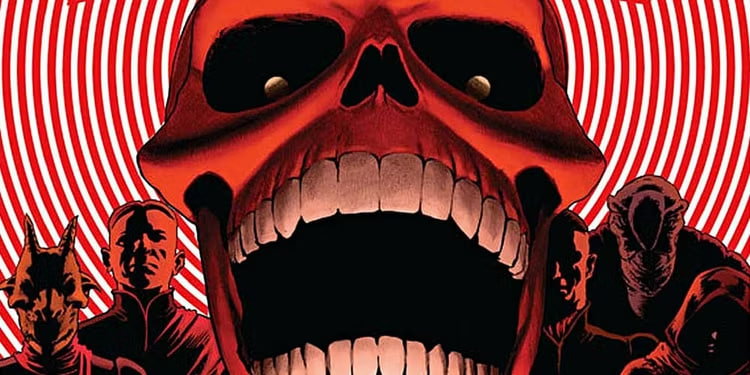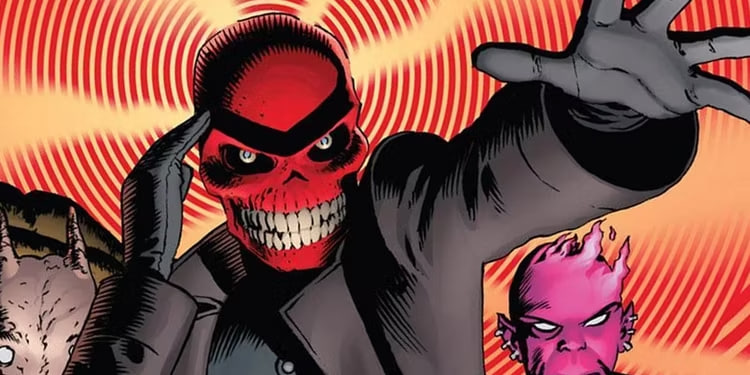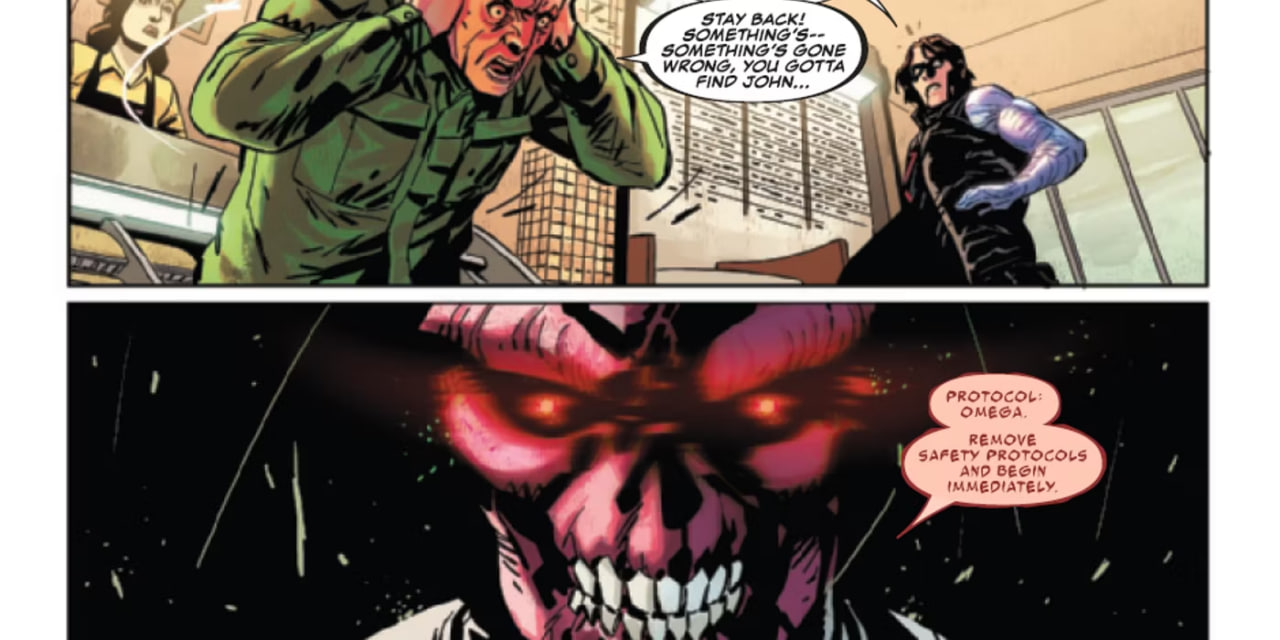One of the oldest and most iconic Marvel villains of all time hasn’t been himself in decades, and it might be time to finally let him go completely.
For more than eighty years, the Marvel Universe has been terrorized by one of the most relentless villains of all time – the Red Skull. As Captain America’s original nemesis, the Red Skull has long been an indelible part of Marvel Comics, yet that same ever-present nature hasn’t exactly translated to other pieces of media. The Red Skull’s place in the likes of the Marvel Cinematic Universe is about as far from what fans are used to as it could be, and the latest run on Thunderbolts may have just proven that it is time for the comics to follow suit.

Rather than dropping readers into any pulse-pounding action, Thunderbolts #3 (by Jackson Lanzing, Collin Kelly, Geraldo Borges, Arthur Hesli, Mahmud Asrar, Jay Bowen, and VC’s Joe Sabino) opens to John Walker, better known as the U.S. Agent, sitting in a bar in Hong Kong while waiting for his next mission to start. Unfortunately for him, said mission is a carefully calculated ploy by none other than the Red Skull to manipulate Walker and his partner, Todd Ziller, aka the American Kaiju, into wreaking havoc overseas. While Walker initially rebuffs this claim, he changes his mind once Ziller loses control of his powers and transformations due to the Red Skull’s unseen influence. As surprising as this is to Walker because the Red Skull is dead, it really shouldn’t be, especially considering death has never kept the villain from coming back previously.
A Brief History of the Red Skull in Marvel Comics
One of Marvel’s Oldest Villains has Always Been Relentless

Introduced all the way back in 1941’s “Red Skull – An Ear for Music!” (by Joe Simon and Jack Kirby, from the pages of Captain America Comics #7), the original Red Skull’s life began as Johann Schmidt, a German boy who lost his mother in childbirth and whose own father tried to kill him for that perceived injustice. After spending years in an orphanage, Johann decided he would do better on the streets. Eventually, Johann found refuge working for a Jewish shopkeeper and their daughter Esther, the latter of whom became the future Red Skull’s first victim when she turned down his advances. With his first murder, the rage and frustration that had been festering away within Johann were let loose. Soon enough, Johann was embracing his darker nature as a member of the Nazi party and, not long after, as Adolf Hitler’s personal protégé.
In the years that followed, Johann was fashioned into the Red Skull, answering only to Hitler himself and standing as the next evolution of the dictator’s plans for the rest of the world. Though the Red Skull had what seemed like all of Hitler’s admiration, that sense of respect only went one way, as the former grew increasingly disillusioned with the latter. By the time World War II was at its end and the defeat of the Axis powers was all but assured, the Red Skull attempted to launch one final attack on Captain America, whom he had come to despise more than any other. Like his Star-Spangled nemesis, the Red Skull would end up in suspended animation for decades before emerging into a world, unlike the one he had left behind, not to mention which had already replaced him as its foremost fascist supervillain.
Why Marvel Comics’ Red Skull Hasn’t Been Himself in a Very Long Time
Captain America’s Original Nemesis is Anything but His Former Self

While Johann Schmidt was caught in his subterranean slumber, another Red Skull rose to claim the legacy left behind by the original as their own. Introduced in 1953’s “Back from the Dead” (by Don Rico, John Romita, and Mort Lawrence, from the pages of Young Men #24), Albert Malik was a Soviet spy turned supervillain who was installed as the latest Red Skull by his government handlers. Although Malik only made a handful of appearances as the Red Skull over the years before his ultimate demise, he set the precedent that anyone willing to cross every line in their pursuit of power could take up that mantle. The next to do so was Aleksander Lukin, another high-ranking Soviet officer, whose reign as the Red Skull was only brought to an end with the first issue of the current Thunderbolts comic.
With dozens of comic book appearances to his name, this put Lukin in action at the same time as another Red Skull, specifically the clone of Johann Schmidt who debuted in 20212’s Uncanny Avengers #1 (by Rick Remender and John Cassaday). Activated shortly after the events of 2012’s Avengers vs. X-Men, which had left the entire world on edge and ripe for being overrun by a returned Red Skull. Like every other Red Skull and fail-safe version of the villain left behind by the original, this clone would eventually lose his life during another epic confrontation with the world’s heroes, opening the door for Lukin and others to step back in to fill that role. And, now that Lukin is gone, the next Red Skull has almost immediately emerged in the form of a mental backup which, while entirely expected at this point, is far from capable of inducing the same sort of terror the character was once synonymous with.
Why It Might Be Time for the Red Skull to Fade Away
Clones and Mental Backups Can Only Sustain Any Character for So Many Iterations

At this point, the idea that the Red Skull would return so quickly after being killed is a trope unto itself. Though that makes it somewhat surprising that the U.S. Agent was so reticent to believe the notion when Shang-Chi brought it up, Walker’s reaction still stands as perfectly reasonable given the circumstances. All of this points toward just how ridiculous the Red Skull as a character is at this point, which the heroes and villains of the Marvel Universe are all seemingly in agreement with.
It isn’t just that the Red Skull never goes away due to others following in the original’s footsteps that has left his overall legacy in a lurch, but that so many of Schmidt’s successors are simply copies of himself in one way or another. Much like how Batman’s prep time has become a point of contention for fans, the Red Skull’s seemingly endless supply of backups gives the villain the kind of edge that is more frustrating than it is anything else.
Worse still, Marvel fans have seen full well that the Red Skull’s presence isn’t one that the Marvel Universe needs through the events of the Marvel Cinematic Universe. Though it isn’t entirely analog to the comics, the MCU was able to utilize the Red Skull as more of a background antagonist than an overt threat in his own right. Despite appearing or being mentioned at multiple points throughout the wider MCU mythos, Hugo Weaving, and later Ross Marquand’s Red Skull chose to manipulate and plot rather than leap into the fray whenever possible.
One of the MCU Red Skull’s most iconic storylines involved him having been thrust into the role of a Stonekeeper, those cursed to keep watch over the Infinity Stones. Even though the Red Skull was freed from that role, so far nothing has brought him back to the forefront of the MCU. Instead, the Red Skull has remained as a legend and inspiration to other villains, not to mention a dire cautionary tale for his world’s modern-day heroes. And, if it could ever let him go, the Red Skull of Marvel Comics could easily find his own legacy returned to its former glory all the same.
